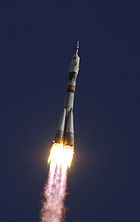 Inaugural launch on 21 October 2011 | |
| Function | Medium-lift launch vehicle |
|---|---|
| Manufacturer | RKTs Progress |
| Country of origin | Russia |
| Cost per launch | US$80 million [1] |
| Size | |
| Height | 46.2 m (151 ft 7 in) |
| Diameter | 10.3 m (33 ft 10 in) |
| Mass | 308,000 kg (679,000 lb) |
| Stages | 4 |
| Capacity | |
| Payload to SSO [a] | |
| Mass | A: 4,230 kg (9,330 lb) B: 4,900 kg (10,800 lb) [2] |
| Payload to GTO [b] | |
| Mass | A:2,810 kg (6,190 lb) B:3,250 kg (7,170 lb) [2] |
| Payload to GSO [c] | |
| Mass | B:1,360 kg (3,000 lb) [3] |
| Associated rockets | |
| Family | R-7 (Soyuz) |
| Based on | Soyuz-2 |
| Comparable | |
| Launch history | |
| Status | Retired |
| Launch sites | Guiana Space Centre, ELS |
| Total launches | 27 |
| Success(es) | 26 |
| Partial failure(s) | 1 |
| First flight | 21 October 2011 [4] |
| Last flight | 10 February 2022 |
| Type of passengers/cargo | |
| Boosters (First stage) – Block B, V, G & D [d] | |
| No. boosters | 4 |
| Height | 19.6 m (64 ft) |
| Diameter | 2.68 m (8 ft 10 in) |
| Empty mass | 3,784 kg (8,342 lb) |
| Gross mass | 44,413 kg (97,914 lb) |
| Propellant mass | 39,160 kg (86,330 lb) |
| Powered by | 1 × RD-107A |
| Maximum thrust | SL: 839.48 kN (188,720 lbf) vac: 1,019.93 kN (229,290 lbf) |
| Specific impulse | SL: 263.3 s (2.582 km/s) vac: 320.2 s (3.140 km/s) |
| Burn time | 118 seconds |
| Propellant | LOX / RP-1 |
| Second stage (core) –Block A | |
| Height | 27.10 m (88.9 ft) |
| Diameter | 2.95 m (9 ft 8 in) |
| Empty mass | 6,545 kg (14,429 lb) |
| Gross mass | 99,765 kg (219,944 lb) |
| Propellant mass | 90,100 kg (198,600 lb) |
| Powered by | 1 ×RD-108A |
| Maximum thrust | SL:792.41 kN (178,140 lbf) vac:921.86 kN (207,240 lbf) |
| Specific impulse | SL:257.7 s (2.527 km/s) vac:320.6 s (3.144 km/s) |
| Burn time | 286 seconds |
| Propellant | LOX / RP-1 |
| Third stage –Block I | |
| Height | 6.70 m (22.0 ft) |
| Diameter | 2.66 m (8 ft 9 in) |
| Empty mass | 2,355 kg (5,192 lb) |
| Gross mass | 27,755 kg (61,189 lb) |
| Propellant mass | 25,400 kg (56,000 lb) |
| Powered by | A:1 ×RD-0110 B:1 ×RD-0124 |
| Maximum thrust | A:298 kN (67,000 lbf) B:294.3 kN (66,200 lbf) |
| Specific impulse | A:326 s (3.20 km/s) B:359 s (3.52 km/s) |
| Burn time | 270 seconds |
| Propellant | LOX / RP-1 |
| Fourth stage –Fregat / Fregat-M / Fregat-MT [5] | |
| Height | 1.5 m (4 ft 11 in) |
| Diameter | Fregat / Fregat-M: 3.35 m (11.0 ft) Fregat-MT: 3.80 m (12.5 ft) |
| Empty mass | Fregat: 930 kg (2,050 lb) Fregat-M: 980 kg (2,160 lb) Fregat-MT: 1,050 kg (2,310 lb) |
| Propellant mass | Fregat: 5,250 kg (11,570 lb) Fregat-M: 5,600 kg (12,300 lb) Fregat-MT: 7,100 kg (15,700 lb) |
| Powered by | 1 ×S5.92 |
| Maximum thrust | 19.85 kN (4,460 lbf) |
| Specific impulse | 333.2 s (3.268 km/s) |
| Burn time | Up to 1,100 seconds (up to 20 starts) |
| Propellant | N2O4 / UDMH |
The Soyuz-ST-A and ST-B were modified versions of the Soyuz-2 rocket, designed to launch from the Guiana Space Centre (CSG) in French Guiana. Developed as part of a European Space Agency (ESA) programme to add a medium-lift launch vehicle to complement the light-lift Vega and heavy-lift Ariane 5 rockets. [6]
Contents
- Soyuz modifications for the Guiana Space Centre
- Launch Infrastructure and Payload Integration
- Enhanced Safety Systems
- Environmental Adaptation
- Vehicle processing
- Launch history
- Inaugural flight
- Flight VS09
- Missions
- Launch sequence
- Notes
- References
- External links
A collaborative effort between Russia and Europe, the project involved constructing the Ensemble de Lancement Soyouz (ELS; lit. 'Soyuz Launch Complex') at the CSG and adapting the Soyuz 2 to the tropical climate. The first launch of a Soyuz ST-B occurred on 21 October 2011, while the first ST-A launch occurred on 17 December 2011.
The Soyuz-ST-A and ST-B were four-stage rockets designed for low Earth orbit missions. Notably, their stage numbering differs from that of some rockets, with the boosters considered the first stage and the central core the second. Unlike the standard Soyuz-2, the Fregat upper stage was mandatory for the ST variants.
Between 2011 and 2022, 27 Soyuz-ST rockets were launched from the CSG, with 26 successful missions. Most of these launches utilized the more powerful ST-B variant, while nine employed the ST-A.
However, the Russia's invasion of Ukraine in 2022 created diplomatic tensions between Russia and Europe, ending Soyuz launches from the CSG. Additionally, the introduction of the Vega C and Ariane 6 launchers, both offering medium-lift capabilities, rendered the role of Soyuz largely redundant.


